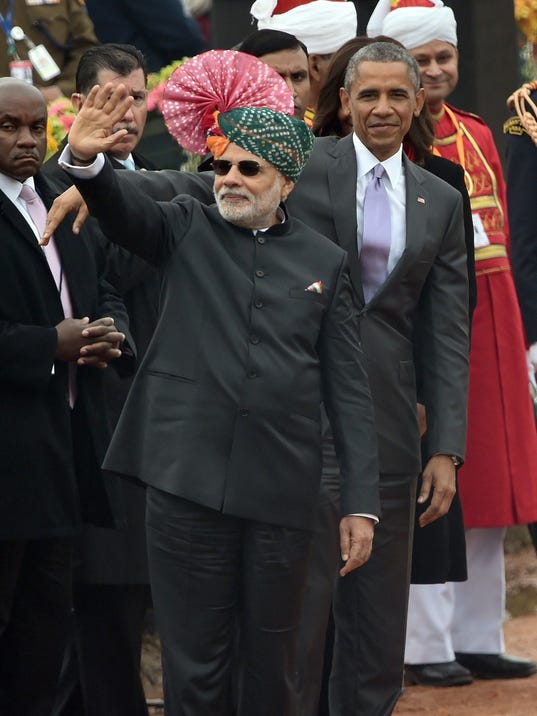 (Photo: Prakash Singh/Getty)★
(Photo: Prakash Singh/Getty)★India and the US will initiate co-production of low-end weapons in India as the two countries renewed their 10-year Defense Framework Agreement during a visit here by US President Barack Obama Sunday through Tuesday.
The agreement, which defines steps to be taken in the next 10 years to bolster their bilateral defense partnership, incorporates for the first time a provision to co-produce weapons in India, along with transfer of technology through the Defense Trade and Technology Initiative (DTTI).
Analysts and serving military officers, however, said it is too early to expect co-development and co-production of advanced weapons systems, and the two countries will need to begin with low-end projects to become familiar with how the DTTI will work as bureaucratic hurdles can impede execution of such projects.
At first, the two countries will co-produce such low-end weapons as the Raven UAV, and reconnaissance modules for the C-130J Super Hercules aircraft bought in 2008, said an Indian Defence Ministry source. More products under DTTI will be identified during next month's visit by Frank Kendall, US undersecretary of defense for acquisition, technology and logistics.
Obama was the first US president to be the guest at the Jan. 26 Republic Day parade. His visit received substantial attention by the media, with analysts describing it as a watershed event and the beginning of a new era in Indo-US strategic relations under the Narendra Modi government.
Analysts and serving officers, however, are divided about whether stronger Indo-US strategic and defense ties would loosen those bonds between India and Russia.
"Russia is a declining power with little to offer India outside of defense technology," said Ashley Tellis, senior associate, Carnegie Endowment for International Peace. "Ties with the US will be comprehensive, ties with Russia will be largely uni-dimensional. India actually comes out ahead in that way," Tellis said.
But Bharat Karnad, professor of national security studies at the Centre for Policy Research, said Indo-Russian defense ties are stable.
"Good relations with the US reflects aspiration, ties with Russia are hard reality. No substantive shift in policy is on the anvil, certainly nothing at the expense of India's relations with Moscow, especially because, unlike the US, Russia has partnered, and continues to partner, India in strategically sensitive technology projects ranging from missiles, ship submersibles, ballistic, nuclear submarines to the Fifth Generation Fighter Aircraft," Karnad said.
The Indian military for decades has been equipped with Russian-made weaponry and equipment and absorption of US-made systems could take time, said a senior Indian Air Force officer.
"There is a challenge in terms of technology-sharing due to US laws and on the part of India technology absorption. This would imply that only a low level of technology-sharing would be practical despite the good intent on both the sides," said Rahul Bhonsle, retired Indian Army brigadier general and defense analyst.
With India-US defense ties restricted only to the purchase of off-the-shelf equipment, the two countries have had no experience in joint weapon development and production, unlike India's experience with Russia and Israel, the MoD source said.
"I think the rise of US-Indian defense production will be slow. America's biggest defense market is domestic, not India. India, in contrast, is one of Russia's two largest defense markets. The contrast explains everything," Tellis said.
Chintamani Mahapatra, professor at the School of International Studies, Jawaharlal Nehru University, said, "There is no doubt that entry of US defense industries into the Indian market will slowly reduce the Russian share of the Indian market. But then the US alone is not going to replace Russia in terms of Indian defense acquisitions. India will continue to diversify its sources of arms purchase."
Since the US sanctions against India were lifted in 2001, India has purchased more than $9 billion in weaponry but it has not included technology transfer, which has been an Indian goal. Unless the two countries are able to effectively execute co-production of high-technology weapon systems, Russia will remain India's main supplier, continue to transfer technology and the hype of the Obama visit will be slowly lost, the Air Force officer said.
"There is considerable concern in Moscow on the warmth shown toward President Obama in New Delhi, but behind the theatrics there has been nothing tangible in the defense and security field that should worry Russia for their primacy in combat systems remains on track," Bhonsle said.
But Tellis is optimistic. "I think there is a clear strategic judgment in India that important though Russia still is for India, Moscow represents the past, Washington represents the future."
Tidak ada komentar:
Posting Komentar
Catatan: Hanya anggota dari blog ini yang dapat mengirim komentar.